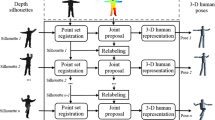Abstract
In this paper, we present a technique for estimating three-dimensional (3-D) human body posture from a set of sequential stereo images. We estimated the pixel displacements of stereo image pairs to reconstruct 3-D information. We modeled the human body with a set of ellipsoids connected by kinematic chains and parameterized with rotational angles at each body joint. To estimate human posture from the 3-D data, we developed a new algorithm based on expectation maximization (EM) with two-step iterations, assigning the 3-D data to different body parts and refining the kinematic parameters to fit the 3-D model to the data. The algorithm is iterated until it converges on the correct posture. Experimental results with synthetic and real data demonstrate that our method is capable of reconstructing 3-D human posture from stereo images. Our method is robust and generic; any useful information for locating the body parts can be integrated into our framework to improve the outcomes.
Similar content being viewed by others
References
Agarwal A, Triggs B (2006) Recovering 3D human pose from monocular images. IEEE Trans Pattern Anal Mach Intell 28(1):44–58
Bishop CM (2006) Pattern recognition and machine learning. Springer, Berlin
Boykov Y, Veksler O, Zabih R (2001) Fast approximate energy minimization via graph cuts. IEEE Trans Pattern Anal Mach Intell 23(11):1222–1239
Cech J, Sara R (2007) Efficient sampling of disparity space for fast and accurate matching. In: IEEE conf on computer vision and pattern recognition, Minneapolis, MN, US, June 2007, pp 1–8
Conaire CO, O’Connor NE, Smeaton AF (2007) Detector adaption by maximising agreement between independent data sources. In: IEEE conf on computer vision and pattern recognition, Minneapolis, MN, USA, June 2007, pp 1–6
Dijkstra EW (1959) A note on two problems in connexion with graphs. Numer Math 1:269–271
Gupta A, Mittal A, Davis LS (2008) Constraint integration for efficient multiview pose estimation with self-occlusions. IEEE Trans Pattern Anal Mach Intell 30(3):493–506
Heckbert PS (1994) Graphics gems IV. Academic Press, San Diego
Horaud R, Niskanen M, Dewaele G, Boyer E (2009) Human motion tracking by registering an articulated surface to 3D points and normals. IEEE Trans Pattern Anal Mach Intell 31(1):158–163
Hua G, Yang M, Wu Y (2005) Learning to estimate human pose with data driven belief propagation. In: IEEE conf on computer vision and pattern recognition, vol 2, San Diego, CA, USA, June 2005, pp 747–754
Knossow D, Ronfard R, Horaud R (2008) Human motion tracking with a kinematic parameterization of extremal contours. Int J Comput Vis 79(3):247–269
Lee MW, Cohen I (2006) A model-based approach for estimating human 3D poses in static images. IEEE Trans Pattern Anal Mach Intell 28(6):905–916
McCarthy JM (1990) Introduction to theoretical kinematics. MIT Press, Cambridge
Menier C, Boyer E, Raffin B (2006) 3D skeleton-based body pose recovery. In: Third international symposium on 3D data processing, visualization, and transmission, Chapel Hill, NC, USA, June 2006, pp 389–396
Mori G, Malik J (2006) Recovering 3D human body configurations using shape contexts. IEEE Trans Pattern Anal Mach Intell 28(7):1052–1062
Mori G, Ren X, Efros AA, Malik J (2004) Recovering human body configurations: combining segmentation and recognition. In: IEEE conf on computer vision and pattern recognition, vol 2, Washington, DC, USA, July 2004, pp 326–333
Murray RM, Li Z, Sastry SS (1994) A mathematical introduction to robotic manipulation. CRC Press, Boca Raton
Plankers R, Fua P (2003) Articulated soft objects for multiview shape and motion capture. IEEE Trans Pattern Anal Mach Intell 25(9):1182–1187
Ramanan D, Forsyth DA, Zisserman A (2007) Tracking people by learning their appearance. IEEE Trans Pattern Anal Mach Intell 29(1):65–81
Ren X, Berg AC, Malik J (2005) Recovering human body configurations using pairwise constraints between parts. In: IEEE international conf on computer vision, vol 1, Beijing, China, October 2005, pp 824–831
Roberts TJ, McKenna SJ, Ricketts IW (2007) Human pose estimation using partial configurations and probabilistic regions. Int J Comput Vis 73(3):285–306
Rosales R, Sclaroff S (2000) Specialized mappings and the estimation of human body pose from a single image. In: IEEE workshop on human motion (HUMO), Austin, TX, USA, December 2000, pp 19–24
Sudderth EB, Ihler AT, Freeman WT, Willsky AS (2003) Nonparametric belief propagation. In: IEEE conf computer vision and pattern recognition, vol 1, Madison, WI, USA, June 2003, pp 605–612
Sundaresan A, Chellappa R (2008) Model driven segmentation of articulating humans in Laplacian Eigenspace. IEEE Trans Pattern Anal Mach Intell 30(10):1771–1785
Sundaresan A, Chellappa R, RoyChowdhury R (2004) Multiple view tracking of humans modelled by kinematic chains. In: IEEE conf on image processing, vol 2, Singapore, October 2004, pp 1009–1012
Taylor CJ (2000) Reconstruction of articulated objects from point correspondences in a single uncalibrated image. Comput Vis Image Underst 80(3):349–363
Tenenbaum JB, de Silva V, Langford JC (2000) A global geometric framework for nonlinear dimensionality reduction. Science 209(5500):2319–2323
Toyoda T, Hasegawa O (2008) Random field model for integration of local information and global information. IEEE Trans Pattern Anal Mach Intell 30(8):1483–1489
Urtasun R, Fua P (2004) 3D human body tracking using deterministic temporal motion models. In: European conference on computer vision, vol 3, Prague, Czech Republic, May 2004, pp 92–106
Wang L, Tan T, Ninh H, Hu W (2003) Silhouette analysis-based gait recognition for human identification. IEEE Trans Pattern Anal Mach Intell 25(12):1505–1518
Wang R, Leow WK (2005) Human body posture refinement by nonparametric belief propagation. In: IEEE conf. on image processing, vol 3, Genoa, Italy, September 2005, pp 1272–1275
Yang HD, Lee SW (2007) Reconstruction of 3D human body pose from stereo image sequences based on top-down learning. J Pattern Recogn 40(11):3120–3131
Author information
Authors and Affiliations
Corresponding author
Rights and permissions
About this article
Cite this article
Thang, N.D., Kim, TS., Lee, YK. et al. Estimation of 3-D human body posture via co-registration of 3-D human model and sequential stereo information. Appl Intell 35, 163–177 (2011). https://doi.org/10.1007/s10489-009-0209-4
Published:
Issue Date:
DOI: https://doi.org/10.1007/s10489-009-0209-4




